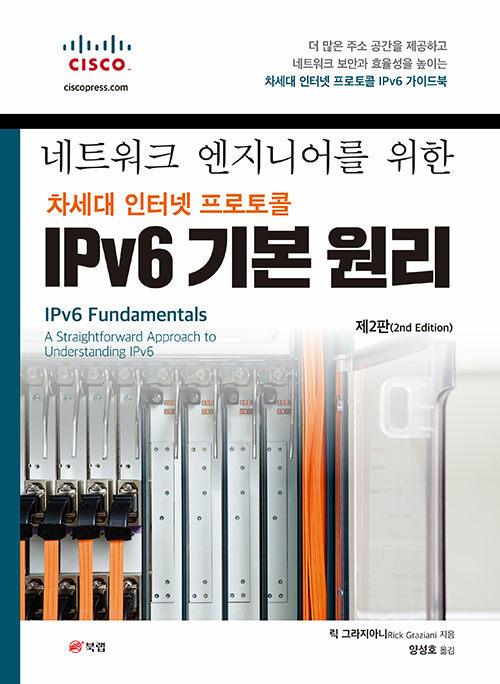- 주문상품수량
- 개
- 예상적립금
P - 상품할인금
- 원
- 배송료
- 원
- 주문합계
- 원
네비게이션 실시간 인기 책

네트워크 엔지니어를 위한 차세대 인터넷 프로토콜 IPv6 기본 원리 (제2판)
- 릭 그라지아니 저
- 북랩
- 2023년 07월 20일
-
정가45,000원
-
판매가40,500원 [10% 할인]
-
페이코혜택가
페이코 혜택가 안내
3천원 이상 구매 시 1,500원 할인ID당 총 3회 할인가능
-
페이코혜택가
페이코 혜택가 안내
3천원 이상 구매 시 500원 할인ID당 총 3회 할인가능
-
결제 혜택무이자
카드할인/포인트결제 안내
제휴카드
반디앤루니스 롯데카드 결제금액 최대 25% 청구할인 (1만원 이상 결제건에 한해 월 2회, 건당 최대 1만원 할인) 반디앤루니스 우리V카드 결제금액 10% 청구할인 포인트결제
OK캐쉬백 포인트 최소 10원부터 전액 사용 or 1% 적립 현대카드 M포인트 결제금액의 최대 10% 사용 가능 신한카드 포인트 결제금액의 최대 10% 사용 가능(일부카드) 하나(구.외환) 포인트 보유 한도 내에서 100% 사용 가능 씨티카드 포인트 결제금액의 최대 50% 사용 가능 할인카드
NH농협 TAKE5카드 20% 청구할인(Edu Pack) 채움 플래티늄 멀티카드 20% 청구할인 모바일 Tmoney 신한카드 10% 청구할인 신한카드 Shopping 10% 청구할인 NH농협 체크카드 10% 청구할인 NH20 해봄 신용카드 10% 청구할인 씨티 클리어 카드 7% 청구할인 NH20 해봄 체크카드 5% 청구할인 NH농협 LADY다솜카드 5% 청구할인 신한카드 큐브 5% 청구할인 신한카드 큐브 PLATINUM# 5% 청구할인 
무이자 안내

-
적립금2,250원 적립 [5%P]
NAVER Pay 결제 시 네이버페이 포인트 5% 적립 ?
추가 적립금 안내
[2천원 추가 적립]
총 주문금액 5만원 이상 구매 시 2,000원 추가 적립
도서(eBook포함)만 구매 시 적립 대상에서 제외업채배송상품 포함(기프트, 업체배송 등) 5만원[멤버십 추가 적립]
슈퍼루니 : 3% 추가 적립
골드루니 : 2% 추가 적립
실버루니 : 1% 추가 적립
단, 국내도서, eBook만 구매 시 적립 불가

-
네이버마일리지적립


-
배송구분업체배송(반디북)
-
배송료무료배송
-
출고예정일
출고예정일 안내
※ 출고예정일은 도서 재고상황에 따라 변동될 수 있습니다.
 2024년 06월 17일(월)
2024년 06월 17일(월)※ 출고예정일은 도서 재고상황에 따라 변동될 수 있습니다.
당일배송 가능지역 검색

“도로명주소”를 쉽게 찾아보세요
1. 도로명으로 검색하기 (예, “직지길” or “직지길+322”)
2. 건물명으로 검색하기 (예, “반디앤루니스빌딩”)
3. 동(읍/면/리) 으로 검색 (예, “인사동” or “인사동+43”)
4. 도로명주소를 모르실 경우 도로명주소 안내시스템(http://www.juso.go.kr)에서 확인해주세요.
주소의 동(읍/리/면) 또는 마지막 부분을 입력하신 후 검색을 누르세요.


지금 이책은
- 판매지수 : 0
이 분야의 베스트셀러
-
 그림으로 공부하는 IT 인프라 구조[개정판]
야마자키 야스시, 미나와 케이코, 아제카츠 요헤이 외
26,000원
그림으로 공부하는 IT 인프라 구조[개정판]
야마자키 야스시, 미나와 케이코, 아제카츠 요헤이 외
26,000원
-
 블루투스와 와이파이 통신을 이용한 아두이노와 앱인벤터 입문+실전(종합편)
장문철
20,000원
블루투스와 와이파이 통신을 이용한 아두이노와 앱인벤터 입문+실전(종합편)
장문철
20,000원
-
 안드로이드 모바일 앱 모의해킹
조정원, 김명근, 조승현 외
36,000원
안드로이드 모바일 앱 모의해킹
조정원, 김명근, 조승현 외
36,000원
책 소개
출판사 리뷰
“쉬운 일은 아니지만, 무리를 마을로 몰고 오는데 한 마리도 잃어버리지 않는다면, 세상에서 그런 기분을 느끼기 힘들 겁니다.”
― 고양이 목동, XXXIV(34회) 슈퍼보울에서 방송된 EDS(Electronic Data Systems)의 광고
IPv6를 배우는 것은 고양이를 키우는 것과 약간 비슷하다. 어디에서 시작할까? 많은 새로운 개념들이 있고, 여러분이 어디에서 시작하든 언제나 다른 것부터 시작하는 것이 더 나았으리라 생각하게 된다. 이것은 각 주제를 이해하기 위해서 얽혀 있는 다른 주제를 이해하고 있어야 하기 때문이다. 이 장은 책의 나머지 부분을 더 잘 이해하는 데 필요한 개념, 프로토콜, 용어에 관한 간략한 소개를 제공한다. 또한, 이 장은 IPv6 및 ICMPv6(Internet Control Message Protocol Version 6)와 관련된 프로토콜에 대한 변경사항에 관한 더 나은 이해를 할 수 있게 해 준다.
- 59쪽,
global unicast 주소(GUA)는 IPv6 네트워크상에서 전 세계적으로 라우팅(globally routable)되고, 접근 가능하다. 이 주소는 IPv4에서 공인 IPv4 주소에 해당한다. GUA 주소는 4장 “IPv6 Address Representation and Address Types”에서 언급했듯이 “aggregatable(축약 가능) global unicast 주소”라고도 한다. GUA 주소는 Figure 5-1에 표시된 여러 유형의 IPv6 unicast 주소 중 하나이다. 이번 장에서는 4장에서 언급한 다음 내용에 대해 자세히 설명한다.
이 장에서는 위의 주제와 추가적인 주제에 관해 좀 더 자세하게 설명을 하겠다. global unicast 주소의 구조를 살피고, 시스코 IOS, Windows, Linux, MAC OS에서 GUA 주소를 수동 설정하는 방법을 알아보겠다.
- 145쪽,
이 장에서는 IPv4의 DHCP와 비슷한 방법인 stateful DHCPv6에 대해 중점을 두고 설명했다. 또한, ISP가 고객에 IPv6 주소 정보를 할당할 때 사용할 수 있는 DHCPv6 프리픽스 위임 옵션에 관해서도 설명하였다.
이 장에서는 stateful DHCPv6에 사용되는 프로세스와 메시지에 관해 확인해 보았다. 라우터는 M 플래그(Managed Address Configuration flag)가 “1”로 설정된 ICMPv6 Router Advertisement 메시지를 보낸다. 이렇게 하면 global unicast 주소 및 기타 설정 정보를 stateful DHCPv6에서 받을 수 있음을 호스트에 알려준다. M 플래그는 다음의 인터페이스 명령을 사용하여 “1”로 설정할 수 있다.
- 353쪽,
Enhanced Interior Gateway Routing Protocol(EIGRP)은 IOS 9.21과 함께 1992년에 소개되었으며, 시스코가 만든 distance-vector, classless 라우팅 프로토콜이다. 이름에서 짐작하겠지만 EIGRP는 시스코의 Interior Gateway Routing Protocol(IGRP)의 개선판이다. EIGRP를 개발한 시스코의 주요 목적은 IGRP의 classless 버전을 만드는 것이었다. EIGRP는 IGRP와 Routing Information Protocol(RIP)과 같은 다른 distance-vector 라우팅 프로토콜에서 일반적으로 찾을 수 없는 몇 가지 특징을 포함하고 있다.
시스코는 EIGRP의 기본 기능을 RFC 7868 “Cisco’s Enhanced Interior Gateway Routing Protocol(EIGRP)”을 통해 개방 표준으로 공개했다. 다른 장비 제조사도 시스코 혹은 또 다른 제조사의 EIGRP를 올린 장비와 연동하기 위해 EIGRP를 구현할 수 있다. 그러나 EIGRP의 향상된 기능(DMVPN 구현을 위해 필요한 EIGRP stub 같은)은 IETF에 공개되지 않았다. RFC 7868은 정보 RFC1이므로 시스코는 EIGRP에 대한 통제를 계속 유지할 것이다.
- 421쪽,
IPv6를 적용하는 것은 광범위한 주제이며 네트워크와 사용자의 필요에 달려있어 다양한 많은 것들을 의미할 수 있다. 이 장의 목적은 여러분들이 네트워크에 IPv6를 적용할 때 고려할 만한 몇 가지 주제를 소개하여 적절한 결론으로 인도하기 위한 것이다.
…(중략)…
이 책 이후에 추천할 만한 IPv6 적용에 대한 가이드는 Tim Martin의 Cisco Press video series “IPv6 Design and Deployment LiveLessions”이다. 이 비디오 시리즈는 네트워크에 IPv6를 적용하는 데 관한 전체적이고 깊은 이해를 제공한다. 다음은 IPv6를 구현할 때 고려해야 할 주제에 대한 멋진 통찰을 제공하는 비디오 시리즈의 전체적인 요약이다.
- 519쪽,
저자 소개
저자: 릭 그라지아니 Rick Graziani
앱토스 소재의 카브릴로대학에서 컴퓨터 네트워킹과 컴퓨터 사이언스 과정을, 산타크루즈의 캘리포니아 대학교 컴퓨터 공학부에서 네트워킹 과정을 가르치고 있다. 시스코 네트워킹 아카데미의 커리큘럼 엔지니어링 팀에 소속되어 있다. 이전에는 산타크루즈 오퍼레이션, 탠덤 컴퓨터, 록히드 미사일 · 스페이스의 정보 기술 분야에서 근무했으며 미국 해안경비대에서 5년간 복무했다.
역자 : 양성호
1997년 한국통신(현 KT)에 입사하였고 1999년에 사내 데이터 전문 교육에 지원하여 6개월간 이수하였으며 당시 IPv6 개요를 과제로 수료했다.
이후 국내외 인터넷 장비를 20년 동안 운용해 왔으며 FTTH 장비를 가장 많이 다룬다.
최근에는 노키아(구 ALU) SR OS 서비스 라 우터의 구현에 관심을 두고 있다. 현재 KT 대구NW운용 본부에서 네트워크 분야 기술 전문직으로 일하고 있다.
목차
Part I Introduction to IPv6
Chapter 1 Introduction to IPv6
IPv6 Is Here
Why Transition to IPv6?
IPv4 Address Depletion
Access to IPv6-Only Customers
Better Performance
Securing Your Current Network
IPv4
IPv4 Address Depletion
CIDR
NAT with Private Addresses
Problems with NAT
NAT is Not Security
NAT Example
What About IPv5?
The Fascinating History of IPv6
Some Background
IPv4 Address Exhaustion and the Need for More International Involvement
A Call for Proposals
A More IP Version of IPv6
IPv6: More Than Just Longer Addresses
IPv6 Myths
Transitioning to IPv6
Summary
Review Questions
References
RFCs
Websites
Chapter 2 IPv6 Primer
Hexadecimal Number System
IPv6 Address Types
Global Unicast Address (GUA)
Link-Local Unicast Address
Unspecified Address
Solicited-Node Multicast Address
Address Terminology
ICMPv6 Neighbor Discovery Protocol (NDP)
Neighbor Solicitation (NS) and Neighbor Advertisement (NA) Messages
Router Solicitation (RS) and Router Advertisement (RA) Messages
Dynamic Address Allocation
Summary
Review Questions
References
RFCs
Chapter 3 Comparing IPv4 and IPv6
Comparing the IPv4 and IPv6 Headers
The IPv4 and IPv6 Version Fields
IPv4 Internet Header Length (IHL) Field
IPv4 Type of Service (ToS) and IPv6 Traffic Class Fields
IPv6 Flow Label Field
IPv4 Total Length Field, IPv6 Payload Length Field, and IPv6 Jumbograms
IPv4 and IPv6 MTUs
IPv4 Fragmentation
IPv6 Fragmentation: IPv6 Source Only
IPv4 Protocol and IPv6 Next Header Fields
IPv4 Time to Live (TTL) and IPv6 Hop Limit Fields
Checksums: IPv4, TCP, and UDP
IPv4 and IPv6 Source Address and Destination Address Fields
IPv4 Options and Padding Fields, IPv6 Fixed Length
IPv6 over Ethernet
Packet Analysis Using Wireshark
Extension Headers
Hop-by-Hop Options Extension Header
Routing Extension Header
Fragment Extension Header
IPsec: AH and ESP Extension Headers
Transport and Tunnel Modes
Encapsulating Security Payload (ESP) Extension Header
Authentication Header (AH) Extension Header
Destination Options Extension Header
No Next Header
Comparing IPv4 and IPv6 at a Glance
Summary
Review Questions
References
RFCs
Websites
Part II IPv6 Addresses
Chapter 4 IPv6 Address Representation and Address Types
Representation of IPv6 Addresses
Rule 1: Omit Leading 0s
Rule 2: Omit All-0s Hextets
Combining Rule 1 and Rule
Prefix Length Notation
IPv6 Address Types
IPv6 Address Space
Unicast Addresses
Global Unicast Address
Link-Local Unicast Address
Loopback Addresses
Unspecified Addresses
Unique Local Addresses
ULA and NAT
L Flag and Global ID
Site-Local Addresses (Deprecated)
IPv4 Embedded Address
IPv4-Mapped IPv6 Addresses
IPv4-Compatible IPv6 Addresses (Deprecated)
Multicast Addresses
Well-Known Multicast Addresses
Solicited-Node Multicast Addresses
Anycast 주소
Summary
Review Questions
References
RFCs
Websites
Book
Chapter 5 Global Unicast Address
Structure of a Global Unicast Address
Global Routing Prefix
Subnet ID
Interface ID
Manual Configuration of a Global Unicast Address
Manual GUA Configuration for Cisco IOS
Manual GUA Configuration with EUI-64 for Cisco IOS
Manual GUA Configuration with IPv6 Unnumbered for Cisco IOS
Manual GUA Configuration for Windows, Linux, and Mac OS
Implementing Static Routing and Verifying Connectivity with Ping
Recognizing the Parts of a GUA Address and the 3?1?4 Rule
Examining Other Prefix Lengths
Subnetting IPv6
Extending the Subnet Prefix
Subnetting on a Nibble Boundary
Subnetting Within a Nibble
Subnetting /127 Point-to-Point Links
NDP Exhaustion Attack
/127 Subnetting on Point-to-Point Links
ipv6gen: An IPv6 Subnetting Tool
Prefix Allocation
Provider-Aggregatable (PA) and Provider-Independent (PI) Address Space
Provider-Aggregatable Address Space
Provider-Independent Address Space
General Prefix Option
Dynamic Addressing Methods with SLAAC and DHCPv6
Summary
Review Questions
References
RFCs
Websites
Chapter 6 Link-Local Unicast Address
Structure of a Link-Local Unicast Address
Automatic Configuration of a Link-Local Address
EUI-64 Generated Interface ID
Verifying the Router’s Link-Local Address on Ethernet and Serial Interfaces
Randomly Generated Interface ID
Zone ID (%) on Link-Local Interfaces
Manual Configuration of a Link-Local Address
Link-Local Address and Duplicate Address Detection
Link-Local Addresses and Default Gateways
ipv6 enable: Isolated Link-Local Address
Pinging a Link-Local Address
Summary
Review Questions
References
RFCs
Chapter 7 Multicast Addresses
Scope
Multicast with Link-Local Scope Versus Link-Local Unicast Addresses
Well-Known Multicast Addresses
Solicited-Node Multicast Addresses
Mapping Unicast Address to Solicited-Node Multicast Address
Mapping to the Ethernet MAC Address
Mapping Solicited-Node Multicast to Ethernet MAC Addresses
Mapping Well-Known Multicast to Ethernet MAC Addresses
Verifying the Address Mappings on Cisco IOS, Windows, and Linux
Multiple Devices Using the Same Solicited-Node Multicast Address
One Solicited-Node Multicast Address for Multiple Unicast Addresses
Multicast Listener Discovery
MLD Snooping
Summary
Review Questions
References
RFCs
Websites, Videos, and Books
Part III Dynamic IPv6 Addressing
Chapter 8 Basics of Dynamic Addressing in IPv6
Dynamic IPv4 Address Allocation: DHCPv4
Dynamic IPv6 Address Allocation
ICMPv6 Router Solicitation and Router Advertisement Messages
Router Advertisement Methods and the A, O, and M Flags
Method 1: Stateless Address Autoconfiguration (SLAAC)
Method 2: SLAAC with Stateless DHCPv6
Method 3: Stateful DHCPv6
DHCPv6 Services
DHCPv6 Terminology and Message Types
DHCPv6 Communications
Summary
Review Questions
References
RFCs
Website
Chapter 9 Stateless Address Autoconfiguration (SLAAC)
The RA Message and SLAAC
On-Link Determination
Generating an Interface ID
Generating the Interface ID Using the EUI-64 Process
Configuring a Windows Host to Use EUI-64
Privacy Extension for Stateless Address Autoconfiguration
Privacy Extension and Generating Randomized Interface IDs
Privacy Extension and Temporary Addresses
Disabling the Use of Temporary Addresses
Autoconfigured Address States and Lifetimes
Example: Autoconfigured Address States and Lifetimes
Displaying IPv6 Lifetimes and State Information on Windows, Linux, and Mac OS
Router Advertisement Fields and Options
Examining the Router Advertisement with Wireshark
Modifying the Valid Lifetime and Preferred Lifetime in the RA Message
Including the DNS Address in the Router Advertisement
Router Advertisement Configuration Options
Default Address Selection
Configuring the Router’s Interface as a SLAAC Client
Summary
Review Questions
References
RFCs
Websites
Other
Chapter 10 Stateless DHCPv6
SLAAC with Stateless DHCPv6
Implementing Stateless DHCPv6
Configuring the RA Message’s Other Configuration Flag
Wireshark Analysis of Router Advertisement: SLAAC and Stateless DHCPv6
Configuring a Router as a Stateless DHCPv6 Server
Verifying Stateless DHCPv6 on a Windows Client
Verifying the Router as a Stateless DHCPv6 Server
DHCPv6 Options
rapid-commit Option
Configuring the Rapid-Commit Option
Relay Agent Communications
DHCPv6 Relay Agent Configuration Commands
Configuring a Unicast DHCPv6 Relay Agent
Configuring a DHCPv6 Relay Agent Using a Multicast Address
Summary
Review Questions
References
RFCs
Websites
Chapter 11 Stateful DHCPv6
Stateful DHCPv6 Messages and Process
Implementing Stateful DHCPv6
Configuring the RA Message M Flag and A Flag
Setting the M Flag to 1 with an A Flag Set to 1
Consequences of Disabling the RA Message or Omitting the Prefix
Setting the M Flag to 1 and Modifying the A Flag to 0
Wireshark Analysis of Router Advertisement: Stateful DHCPv6
Configuring a Router as a Stateful DHCPv6 Server
The Address Prefix Command
Verifying Stateful DHCPv6 on a Windows Client
Verifying the Router as a Stateful DHCPv6 Server
DHCPv6 Options
IPv6 Prefix Delegation Options for DHCPv6
Sample Configuration: Prefix Delegation with DHCPv6
DHCPv6-PD Process
HOME Router (Requesting Router) Configuration and Verification
ISP Router (Delegating Router) Configuration and Verification
Verifying Prefix Delegation with DHCPv6 on WinPC
Summary
Review Questions
References
RFCs
Websites
Part IV ICMPv6 and ICMPv6 Neighbor Discovery
Chapter 12 ICMPv6
General Message Format
ICMP Error Messages
Destination Unreachable
Packet Too Big
Path MTU Discovery
Time Exceeded
Parameter Problem
ICMP Informational Messages
Echo Request and Echo Reply
Pinging a Global Unicast Address
Pinging a Link-Local Address
Summary
Review Questions
References
RFCs
Chapter 13 ICMPv6 Neighbor Discovery
Neighbor Discovery Options
Default Router and Prefix Determination
Router Solicitation Message
Router Advertisement Message
Address Resolution
The Address Resolution Process
Characteristics of the Neighbor Solicitation Message
Format of the Neighbor Solicitation Message
Format of the Neighbor Advertisement Message
Neighbor Cache
Destination Cache
Duplicate Address Detection (DAD)
Neighbor Unreachability Detection (NUD)
Redirect Message
Summary
Review Questions
References
RFCs
Part V Routing IPv6
Chapter 14 IPv6 Routing Table and Static Routes
Configuring a Router as an IPv6 Router
Understanding the IPv6 Routing Table
Codes: NDp and ND
Code: Connected
Code: Local
Configuring IPv6 Static Routes
Static Routes with a GUA Next-Hop Address
Static Routes with a Link-Local Next-Hop Address
Static Routes with Only an Exit Interface
Default Static Routes with Link-Local Next-Hop Addresses
Verifying IPv6 Static Routes
Summarizing IPv6 Routes
IPv6 Summary Static Route
CEF for IPv6
Summary
Review Questions
References
RFCs
Websites
Books
Chapter 15 EIGRP for IPv6
Comparing EIGRPv4 and EIGRPv6
Classic EIGRP for IPv6
Configuring Classic EIGRP for IPv6
Verifying Classic EIGRP for IPv6
EIGRP Named Mode for IPv6
Configuring EIGRP Named Mode for IPv6
Verifying EIGRP Named Mode for IPv6
Comparing EIGRP Named Mode for IPv4 and IPv6
Summary
Review Questions
References
RFC
Websites
Books
Chapter 16 OSPFv3
Comparing OSPFv2 and OSPFv3
Traditional OSPFv3
Configuring Traditional OSPFv3
ASBR and Advertising a Default Route
Area Border Router with Totally Stubby Area
Internal Router: Totally Stubby Area
Advertising a Default Route
Verifying Traditional OSPFv3
OSPFv3 with Address Families
Configuring OSPFv3 with AF
ASBR and Advertising a Default Route
ABR with Totally Stubby Area
Internal Router: Totally Stubby Area
Verifying OSPFv3 with AF
Configuring OSPFv3 for an IPv4 Island
Summary
Review Questions
References
RFCs
Websites
Books
Part VI Implementing IPv6
Chapter 17 Deploying IPv6 in the Network
IPv6 Address Plan Considerations
Encoding Information in the Subnet ID
VLAN-Mapped Subnet ID
IPv6 Address Plans
IPv6 VLANs
IPv6 First Hop Redundancy Protocols
ICMPv6 Neighbor Discovery
HSRP and VRRP
GLBP
Selecting an FHRP
Dual Stack
IPv6 Address Format in URL Syntax
DNS
DNS Query and Response
Happy Eyeballs
IPv6 Access Control Lists
Configuring IPv6 ACLs
Transition Technologies
Translation with NAT64
Traffic Initiated from IPv6-Only Clients to IPv4-Only Servers
Traffic Initiated from IPv4-Only Clients to IPv6-Only Servers
Other Translation Techniques
Tunneling IPv6
Conclusion
Summary
Review Questions
References
RFCs
Websites
Appendixes
Appendix A Configuring NAT64 and IPv6 Tunnels
Configuring NAT64
Configuring IPv6 Tunnels
Manual Tunnels
6to4 Tunnels
6to4 Tunnels and Loopback Interfaces
ISATAP
Appendix B IPv6 Command Quick Reference
Cisco IOS Commands
Addressing Commands
Global Unicast Address and Unique Local Unicast Addresses
Link-Local Unicast Address
General Prefix
DNS host commands
Verifying Address Information
ICMPv6 Router Advertisement Commands
Enabling ICMPv6 Router Advertisements
인터페이스상에서 Router Advertisement 파라미터를 수정한다
Verifying Router Advertisements
Configuring a DHCPv6 Server
Stateless DHCPv6 Configuration Pool Commands
Stateful DHCPv6 Configuration Pool Commands
Associating the DHCPv6 Pool to an Interface
DHCPv6 Relay
Verifying DHCPv6 Information
IPv6 Access Control Lists
Configuring IPv6 ACLs
Verifying IPv6 ACLs
Static Routes, Displaying the Routing Table, and CEF for IPv6
Static Routes
Verifying Static Routes
CEF for IPv6
EIGRP for IPv6
Classic EIGRP for IPv6
EIGRP Named Mode
EIGRP for IPv6 Verification Commands
OSPFv3
Configuring Traditional OSPFv3
Verifying Traditional OSPFv3
Configuring OSPFv3 with Address Families
Verifying OSPFv3 with Address Families
Host Operating System Commands
Windows OS 5
General Commands
Interface Addresses Information
SLAAC Interface ID
Linux OS
General Commands
Address Configuration Commands
Mac OS X
General Commands
Address Configuration Commands
Appendix C Answers to Review Questions
Index
배송 시 유의사항
- 반디앤루니스에서 구매하신 도서는 물류 대행 위탁업체 웅진 북센을 통해 배송됩니다.
(배송 포장에 "웅진 북센"으로 표기될 수 있습니다.)
- 구매한 상품의 품질과 배송 관련 문의는 반디앤루니스로 문의 바랍니다.
- 천재지변 및 택배사의 사정에 따라 배송이 지연될 수 있습니다.
- 결제(입금) 완료 후 출판사 및 유통사의 사정으로 품절 또는 절판 되어 상품 구입이 어려울 수 있습니다. (별도 안내 예정)
- 도서산간지역의 경우 추가 배송비가 발생될 수 있습니다.
반품/교환
상품 설명에 반품/ 교환 관련한 안내가 있는 경우 그 내용을 우선으로 합니다. (업체 사정에 따라 달라질 수 있습니다)
반품/교환
-
반품/교환 반품/교환 방법 홈 > 고객센터 > 자주찾는질문 “반품/교환/환불” 안내 참고 또는 1:1상담게시판 반품/교환 가능 기간 반품,교환은 배송완료 후 7일 이내, 상품의 결함 및 계약내용과 다를 경우 문제발견 후 30일 이내에 신청가능 반품/교환 비용 변심 혹은 구매착오의 경우에만 반송료 고객 부담(별도 지정 택배사 없음) 반품/교환 불가 사유 - 소비자의 책임 사유로 상품 등이 손실 또는 훼손된 경우
- 소비자의 사용, 포장 개봉에 의해 상품 등의 가치가 현저히 감소한 경우
- 복제가 가능한 상품 등의 포장을 훼손한 경우 : 예)만화책, 잡지, 화보집 등
- 시간의 경과에 의해 재판매가 곤란한 정도로 가치가 현저히 감소한 경우
- 전자상거래등에서의 소비자보호에 관한 법률이 정하는 소비자 청약철회 제한 내용에 해당되는 경우
- 해외주문 상품(해외 원서)의 경우(파본/훼손/오발송 상품을 제외)
소비자 피해보상
환불지연에 따른 배상- 상품의 불량에 의한 반품, 교환, A/S, 환불, 품질보증 및 피해보상 등에 관한 사항은
소비자 분쟁해결 기준(공정거래위원회고시)에 준하여 처리됨 - 대금 환불 및 환불지연에 따른 배상금 지급 조건, 절차 등은 전자상거래 등에서의
소비자 보호에 관한 법률에 따라 처리함
반품/교환 주소 경기도 파주시 문발로 77, 웅진북센(반디앤루니스)





